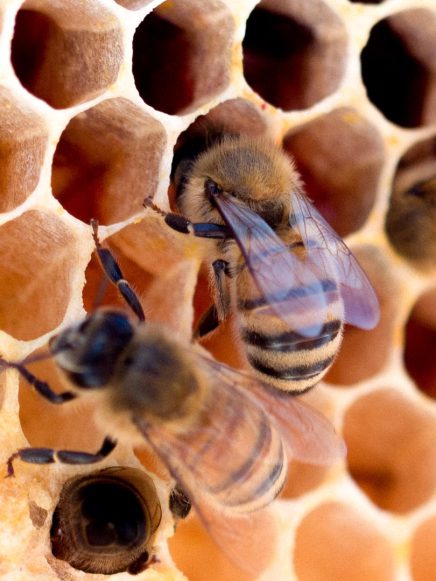Productinformation Honey

Honey
Honey is a liquid substance full of natural sugars, minerals and trace elements, which is created when bees collect nectar from flowers and then "convert" them. The nectar is converted into honey by adding enzymes and thickening by means of evaporation. By converting the nectar into honey, the liquid becomes richer in sugars, more nutritious and has a longer shelf life.
The forager bees from a bee colony suck up the moist nectar from flowers and blossoms in their honey stomach and add the first enzymes and good bacteria directly from their salivary glands and their thorax. After returning home to their hive, the enriched nectar is given to the house bees. Because the nectar is then taken over several times by the bees from each other, more and more enzymes are added to the honey. This takeover between the worker bees happens a lot during the evaporation of the nectar. By ventilation in the hive, which the bees often take care of themselves, the nectar is thickened from a moisture content of about 80% to a moisture content of about 20%. Only then is the honey covered with a wax lid in the cell. Then the maturation begins. During this ripening, the sucrose from the nectar is largely converted into glucose and fructose. When the honey is sufficiently ripened, it can be harvested by the beekeeper. When a beekeeper sees that a honey frame is completely sealed, i.e. completely covered with wax lids, he can take the window out of the hive and follow the processing process. This can include:
Pressing
During pressing, the honeycombs are crushed and the resulting mixture is pressed through a cloth, leaving the wax particles behind. This was especially the case in the past with honey from beehives.
Comb honey
Comb honey is honey that has been stored by the bees in completely new comb without the beekeeper having used artificial comb. Comb honey is also called section honey, especially if there are neat square pieces of comb honey (and especially if it is straight from the hive between 4 planks – where the bees have stored it between those 4 planks themselves). Because the bees have built the combs all by themselves, it is possible to eat the comb honey whole.
Chunk honey
Chunk honey (also called comb chunk in honey) is comb honey that has been put in a jar after which the jar is further filled with liquid honey. The liquid honey and the piece of comb may be of the same type, but often acacia honey or robinia honey is used for the liquid honey because it remains liquid for a very long time. This is important for sales because when the honey crystallizes, you no longer see the honeycomb.
Cream honey
When the beekeeper inoculates the honey with a very small amount of fine crystallizing honey before it is put in jars and then stirs the honey daily for a few weeks, the end product is cream honey. This honey does not crystallize further and therefore remains supple and spreadable for a very long time.
Taste and shelf life
When there is more pollen in the honey, the honey will "saccharify" or crystallize faster. This is a natural process. It is possible to liquefy this honey again by heating it slightly, certainly not higher than 40° Celsius, otherwise the enzymes and good bacteria in the honey will die. Then only a sweet substance remains, which has little nutritional value.
The crystallization of honey is therefore a sign that the honey has not been heated and all the nutrients are still present. Honey that has been heated above 40° Celsius no longer crystallizes. "Saccharified" honey also has a very long shelf life and retains its nutritional value for a very long time. Usually much longer than indicated on the pot.
As far as the taste of honey is concerned, it can be roughly stated that the darker the honey in color, the spicier the taste.

Puur honen | Avocadohoning | Sinaasappelhoning | Dennenhoning | Rozemarijnhoning | Boekweithoning | Eucalyptushoning | Kastanjehoning | Lavendelhoning | Lindehoning | Tijmhoning | Bloemenhoning | Acaciahoning | Rauwe honing | Natuurlijke honing | Echte honing | Biologische honing | Linde balı | Avokadobalı | Karabuğdaybalı | Akasyabalı | Portakalçiçeğibalı | Çiçekbalı | Lavantabalı | Biberiyebalı | Çambalı | Kekikbalı | Kestanebalı | Okaliptüsbalı | Gerçek bal | Ham bal | Saf bal | Organik bal | Doğal bal |
